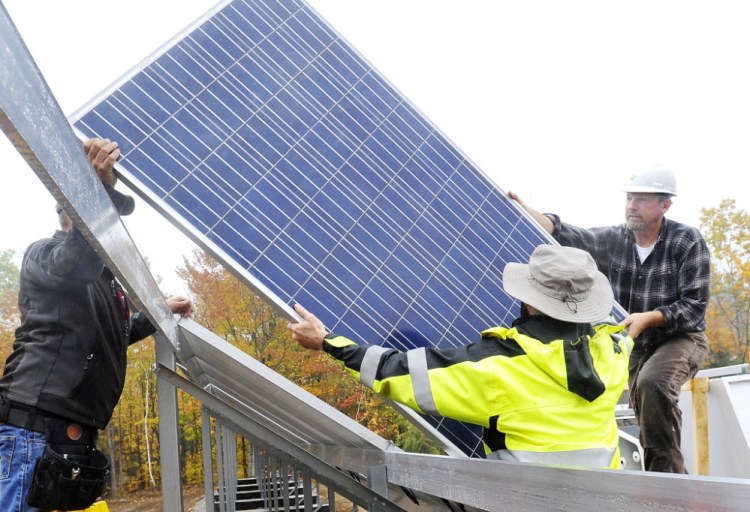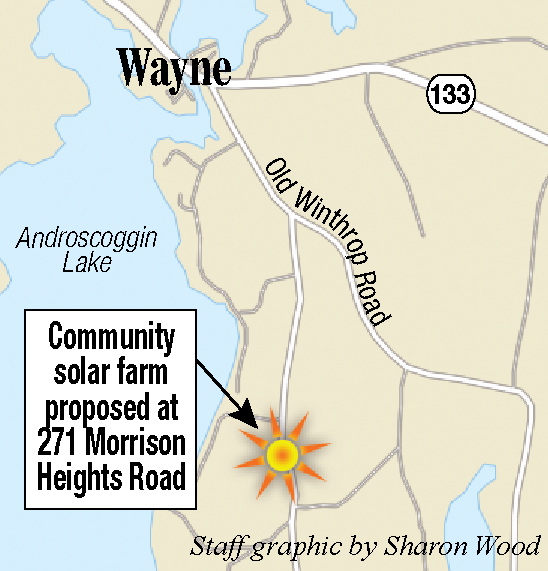A planned community solar farm near Androscoggin Lake in Wayne is one of about 10 similar projects that are under development around the state.
The projects are unlike traditional residential solar installation in that the households benefiting from the solar-generated power aren’t actually located on the sites of the solar arrays. Instead, the power goes to Central Maine Power Co.’s grid, and the customers get credit for the power to pay for their own electricity bills.
The first community solar farm in Maine was built last fall in South Paris, and the proposed project in Wayne would become the third such project if completed this fall as expected, said Fortunat Mueller, co-founder of ReVision Energy, the company developing the projects. The other completed project is in Edgecomb.
So far, two customers have committed themselves to investing in the Wayne project, and ReVision Energy energy is seeking seven more. The company is hosting a presentation about community solar farms at 7 p.m. Sept. 15 at the Memorial Chapel at Camp Mechuwana in Winthrop.
Mueller, based in the company’s Portland headquarters, said he expects community solar farms such as the one proposed in Wayne will play a growing role in the future of solar power in Maine.
Unlike rooftop solar arrays, community solar farms allow anyone in the electricity utility coverage area to invest in the project. The cooperative projects can open the doors for people who can’t install solar panels where they live, perhaps because their homes are too shady or they live in apartments, and bring the individual investment costs down with better economies of scale, Mueller said.
“Even though we have a fairly rural and sparsely populated state, a majority of people live or work in buildings that don’t have great solar power opportunities,” he said.
Part of what makes solar farms possible is Maine’s net-metering rule, which allows people with solar panels to sell the power back utility companies as credit for their own electricity usage. But there’s an effort underway in the state to find better long-term alternatives to net metering.
The Legislature directed the Maine Public Utilities Commission earlier this year to put together a group of solar power stakeholders to develop an alternative to net metering and issue a report to the Legislature’s Energy, Utilities and Technology Committee by the end of January. The group’s first meeting is scheduled for Thursday.
A goal driving the process is to allow all types of customers to benefit from solar energy, and community solar projects are a big part of that, said Maine Public Advocate Timothy Schneider, whose office developed a white paper establishing an alternative framework to net metering that will serve as a starting point for the stakeholder group.
CMP supports the effort but has opposed net metering, saying it pushes more of the burden of maintaining the utility company’s infrastructure onto customers not generating solar power.
John Carroll, spokesman for Iberdrola USA, the parent company of CMP, said the utility company is supportive of diverse sources of electricity, especially renewable sources, but its costs for operating the grid don’t decrease for solar customers. Over time, net metering allows people with solar power to avoid paying the true cost of being connected to the grid, he said.
But Carroll said the company views solar farms positively from an environmental standpoint and because they highlight the importance of the grid for solar power.
Another potential policy change that would affect solar farms is a push by some to expand the number of customers allowed on each project. The Maine PUC now caps the users of a community solar farm at 10, which includes the landowner, Mueller said.
The bill that later became the resolve establishing the net-metering study originally called for lifting the cap on users of community solar projects, but that portion wasn’t included in the final bill.
Schneider, the state’s public advocate, said increasing the number of users of community solar farms is a possible outcome of the stakeholder group’s work.
The owner of the 95 acres near Androscoggin Lake in Wayne for which the solar farm is planned, Rosanne Graef, of Portland, said she might be interested in hosting another solar project if the cap is lifted.
Phil Kerber is one of the customers who already signed on to join the Wayne community solar farm. Kerber, a state worker who lives in Freeport with his wife, Carla, said they decided to join a community solar farm instead of installing their own solar panel system because it made more sense in the long term.
They probably will have to replace their roof in the next 15 years, and having a solar array installed on it would make the job more complicated, Kerber said. He also liked the idea of not dealing with maintaining the panels.
“You buy into it, and it’s like, out of sight and out of mind,” Kerber said.
The investment will cost the Kerbers around $21,000 before a 30 percent federal rebate, he said. Depending on their electricity usage, Kerber expects the investment will be paid off with the savings in about 15 to 20 years. But for the Kerbers, the eventual savings aren’t the only reason they’re investing in the solar farm.
“It’s really just the right thing to do,” Kerber said. “It’s a good example to set for our family.”
Paul Koenig — 621-5663
Twitter: @pdkoenig
Send questions/comments to the editors.



